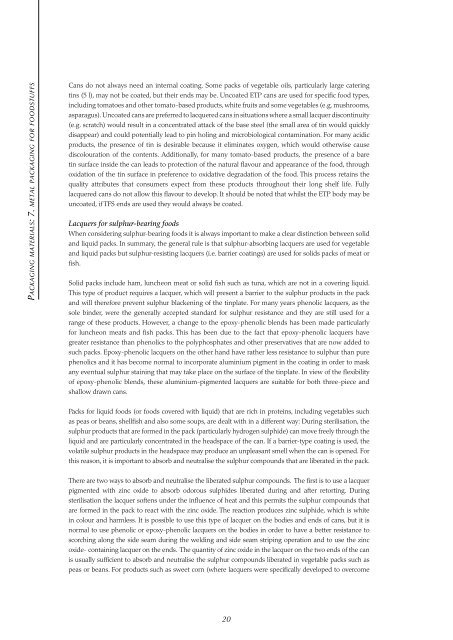packaging materials 7. metal packaging for foodstuffs - Europa
packaging materials 7. metal packaging for foodstuffs - Europa
packaging materials 7. metal packaging for foodstuffs - Europa
You also want an ePaper? Increase the reach of your titles
YUMPU automatically turns print PDFs into web optimized ePapers that Google loves.
Pa c k a g i n g ma t e r i a l s: <strong>7.</strong> m e t a l pa c k a g i n g f o r f o o d s t u f f sCans do not always need an internal coating. Some packs of vegetable oils, particularly large cateringtins (5 l), may not be coated, but their ends may be. Uncoated ETP cans are used <strong>for</strong> specific food types,including tomatoes and other tomato-based products, white fruits and some vegetables (e.g. mushrooms,asparagus). Uncoated cans are preferred to lacquered cans in situations where a small lacquer discontinuity(e.g. scratch) would result in a concentrated attack of the base steel (the small area of tin would quicklydisappear) and could potentially lead to pin holing and microbiological contamination. For many acidicproducts, the presence of tin is desirable because it eliminates oxygen, which would otherwise causediscolouration of the contents. Additionally, <strong>for</strong> many tomato-based products, the presence of a baretin surface inside the can leads to protection of the natural flavour and appearance of the food, throughoxidation of the tin surface in preference to oxidative degradation of the food. This process retains thequality attributes that consumers expect from these products throughout their long shelf life. Fullylacquered cans do not allow this flavour to develop. It should be noted that whilst the ETP body may beuncoated, if TFS ends are used they would always be coated.Lacquers <strong>for</strong> sulphur-bearing foodsWhen considering sulphur-bearing foods it is always important to make a clear distinction between solidand liquid packs. In summary, the general rule is that sulphur-absorbing lacquers are used <strong>for</strong> vegetableand liquid packs but sulphur-resisting lacquers (i.e. barrier coatings) are used <strong>for</strong> solids packs of meat orfish.Solid packs include ham, luncheon meat or solid fish such as tuna, which are not in a covering liquid.This type of product requires a lacquer, which will present a barrier to the sulphur products in the packand will there<strong>for</strong>e prevent sulphur blackening of the tinplate. For many years phenolic lacquers, as thesole binder, were the generally accepted standard <strong>for</strong> sulphur resistance and they are still used <strong>for</strong> arange of these products. However, a change to the epoxy-phenolic blends has been made particularly<strong>for</strong> luncheon meats and fish packs. This has been due to the fact that epoxy-phenolic lacquers havegreater resistance than phenolics to the polyphosphates and other preservatives that are now added tosuch packs. Epoxy-phenolic lacquers on the other hand have rather less resistance to sulphur than purephenolics and it has become normal to incorporate aluminium pigment in the coating in order to maskany eventual sulphur staining that may take place on the surface of the tinplate. In view of the flexibilityof epoxy-phenolic blends, these aluminium-pigmented lacquers are suitable <strong>for</strong> both three-piece andshallow drawn cans.Packs <strong>for</strong> liquid foods (or foods covered with liquid) that are rich in proteins, including vegetables suchas peas or beans, shellfish and also some soups, are dealt with in a different way: During sterilisation, thesulphur products that are <strong>for</strong>med in the pack (particularly hydrogen sulphide) can move freely through theliquid and are particularly concentrated in the headspace of the can. If a barrier-type coating is used, thevolatile sulphur products in the headspace may produce an unpleasant smell when the can is opened. Forthis reason, it is important to absorb and neutralise the sulphur compounds that are liberated in the pack.There are two ways to absorb and neutralise the liberated sulphur compounds. The first is to use a lacquerpigmented with zinc oxide to absorb odorous sulphides liberated during and after retorting. Duringsterilisation the lacquer softens under the influence of heat and this permits the sulphur compounds thatare <strong>for</strong>med in the pack to react with the zinc oxide. The reaction produces zinc sulphide, which is whitein colour and harmless. It is possible to use this type of lacquer on the bodies and ends of cans, but it isnormal to use phenolic or epoxy-phenolic lacquers on the bodies in order to have a better resistance toscorching along the side seam during the welding and side seam striping operation and to use the zincoxide- containing lacquer on the ends. The quantity of zinc oxide in the lacquer on the two ends of the canis usually sufficient to absorb and neutralise the sulphur compounds liberated in vegetable packs such aspeas or beans. For products such as sweet corn (where lacquers were specifically developed to overcome20

















